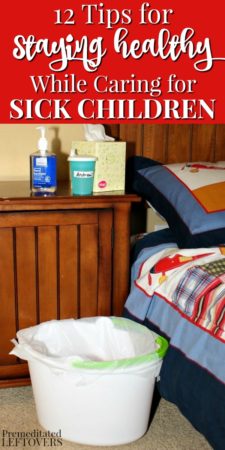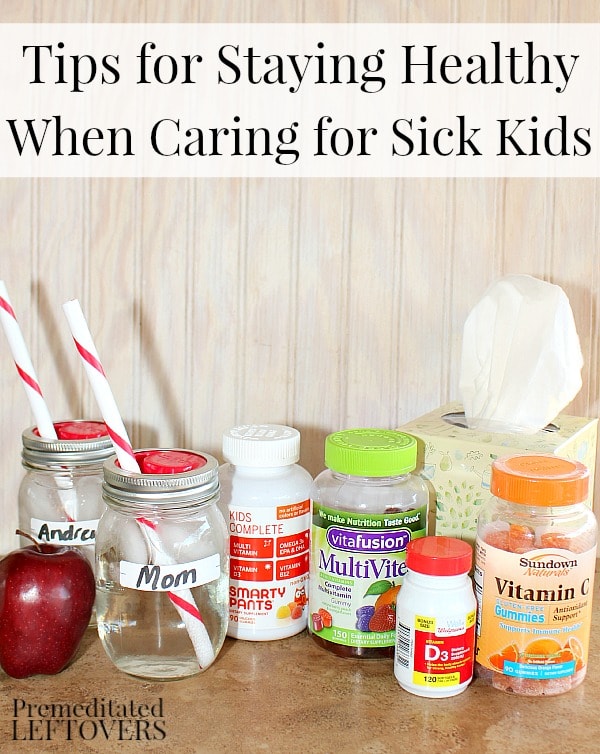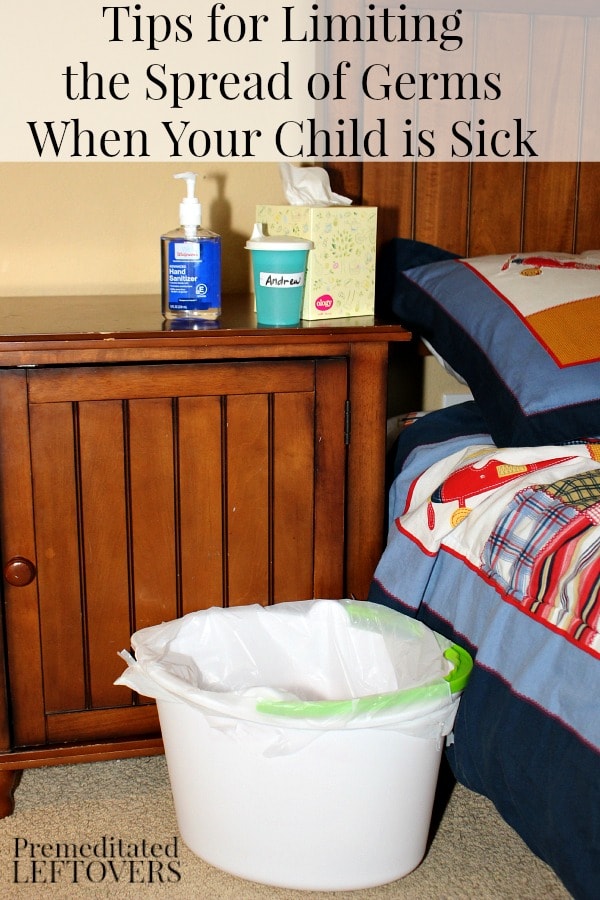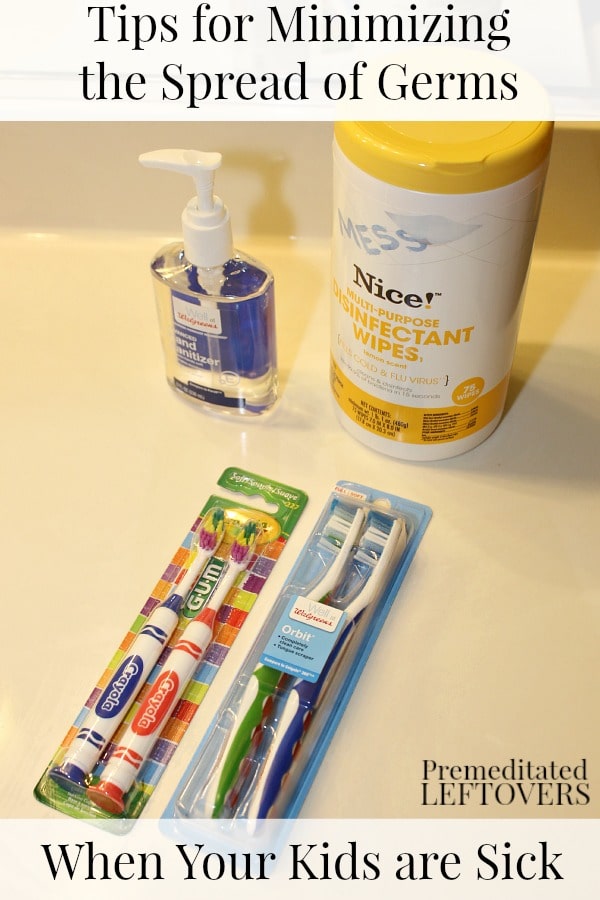Use these tips for staying healthy when caring for sick kids next time your child is sick.
It’s spring, and I wish I could say we were past cold and flu season. I also wish I could tell you that I was getting so much sunshine from playing in the garden that I have decreased my Vitamin D supplements. However we have been particularly hard hit with viruses this spring, so I have been stuck inside taking care of my kids. My kids have each brought home a different, but equally ugly, virus from their schools.
Despite having sick kids, I have escaped the last couple of viruses. This may be because Vitamin C is still my BFF, but I thought I would share a few other things I am doing to try to stay healthy while taking care of sick kids.
12 Tips for Staying Healthy When Caring for Sick Kids
My daughter teases that my tips for staying healthy when caring for sick kids should be adopted by the CDC for preventing epidemics. While some of the tips may seem extreme, I would rather be extra cautious than lose a week to illness myself after spending a week taking care of sick kids.
1. Wash your hands frequently.
I know we hear this advice a lot but there is a very good reason that we do. Scrub your hands for at least 20 seconds before rinsing, then dry with a clean towel. I like to keep lotion by the sink to help prevent my hands from drying out from all the washing.
2. Don’t touch your face.
In addition to washing your hands, do not touch your face, nose or rub your eyes. If you do touch your face, wash your face well as soon as you can. It may sound crazy, but I learned this from my kids’ pediatrician. He accidentally touched his face after examining one of my sick kids and he immediately went to the sink in the room and scrubbed his face. I have used this trick when I have accidentally touched my face and believe it has helped prevent me from catching my kids’ colds.
3. Try to keep your child in one room as much as possible.
I like to set up a command center in the family room because it is convenient for me, but sometimes a child feels more comfortable in their room. Limiting movement throughout the house minimizes the number of germs spread throughout the house. I normally discourage eating in bed or on the couch, but I make an exception when my kids are sick. I would rather have them eat in their “sick room” than have them at the kitchen table where they can more easily spread germs to the rest of the family.
Let the sick child skip chores. Once your child is feeling better it is tempting to allow them to go back to their normal routine. However, if they are still contagious, you do not want them to spread germs while unloading the dishwasher or dusting. Ask you doctor how long they are contagious to determine when they can resume their normal activities.
4. Keep a trash can by your child.
Line a bucket or small trash can with a grocery bag and place it near where your child is resting. This will allow them to throw away tissues or have a receptacle available if they need to vomit. Then you can knot the bag and throw it away without coming into direct contact with the contents.
5. Discourage accidental sharing.
Label cups and water bottles to make sure you don’t accidentally drink from each other’s cups. If you have several young children, be sure to distinguish the sick child’s dishes from the other kids. You don’t want brother or sister to accidentally share their virus while sharing Cheerios.
6. Use Disposable Products
Switch to disposable tissues and other paper products when your child is sick. We use cloth handkerchiefs for allergies, but tissues for all viruses and bacterial infections. I also use disposable disinfectant wipes to wipe up after my kids when they are sick, so I don’t have to worry about being exposed to germs from washcloths and towels on laundry day.
You might want to consider allowing your sick child to eat off of paper plates and use disposable utensils so that the “dishes” can be thrown away rather than risk spreading germs around the kitchen. If you don’t use disposable dishes, make sure the sick child’s dirty dishes are washed immediately with soap and hot water, then put in the dishwasher and run on the hottest setting.
7. Disinfect the surfaces your child touches.
Frequently clean the T.V. remote, doorknobs, telephone, bathroom counters and any other surfaces your child touches. To make it easier to clean surfaces while my child is sick, I keep disinfectant wipes handy. I can run the wipes over all the surfaces as soon as the child leaves that room. Once the child is well, I go through and thoroughly disinfect the house and their belongings.
8. Isolate the sick child’s toothbrush.
As soon as someone in our house is sick, we remove their toothbrush from the bathroom drawer, so it doesn’t come in contact with the other toothbrushes. We also don’t allow their toothbrush to come into contact with a tube of toothpaste that anyone else uses. We have developed the habit of each child having their own tube of toothpaste. However, if your kids share a tube of toothpaste, then use a travel size toothpaste for the sick child or dispense a small amount of toothpaste onto a clean plate and then add some to the sick child’s toothbrush. That way you don’t transfer germs via a shared toothpaste tube. Replace the child’s toothbrush as soon as they are well.
9. Limit cuddles.
This is the hardest one to enforce, and this not practical if you have very young children. However, once your child is school-aged, you should be able to cut back on cuddling your kids when they are sick. One thing I have found is that my kids find comfort in being wrapped or covered with my blanket when sick, so I loan my blanket and occasionally my pillow to the sick child. Instead of bringing a sick child into my bed, I set them up on the love seat and I sleep on the couch. I am close by if they need me, but they are not coughing a few inches from my face.
10. Wash your child’s clothing and linens in hot water.
Wash your child’s clothing, bedding, and towels in hot water to help kill germs. My kids live in pajamas when they are sick. Since their pajamas are not made of 100% cotton, they are safe to wash in hot water. Check the labels on your child’s clothes and if safe, wash them in hot water. You can add bleach to white loads.
11. Take care of yourself.
Be sure to take care of yourself while you are taking care of your child. Take your vitamins, eat healthy meals, and be sure to drink plenty of liquids. This is probably the hardest tip to put into practice, other than limiting cuddles, but it is very important. You cannot take care of your family properly if you don’t take care of yourself.
Just like when your child was a baby, sleep when they sleep. Napping when they nap will help make up for any sleep you lose taking care of them at night.
12. Ask for help!
Don’t be afraid to ask for help from family, friends, or neighbors. If you need an item, ask a friend to pick it up for you. They can leave it on the porch rather than come inside so that they are not exposed to the virus. Fortunately, my husband is in town, so he was able to run to Walgreens for me yesterday to pick up more tissues and Vitamin C.
More Tips for Cold & Flu Season
10 Ways to Keep Your Family Healthy This Winter
How to Create a Sick Day Kit for Kids
10 Ways to Teach Kids About Germs





Leave a Reply